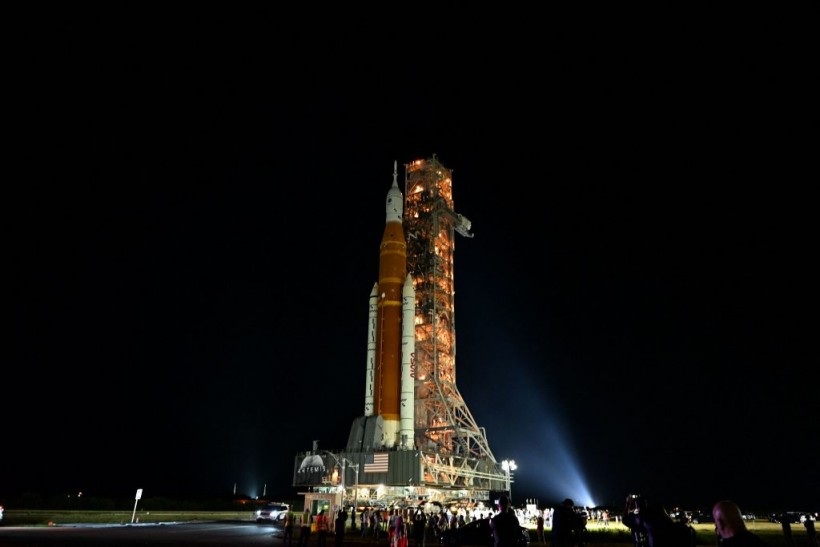National Aeronautics and Space Administration (NASA) said that Wednesday's cryogenic tanking test for Space Launch System (SLS) was successful, providing evidence that a fixed hydrogen leak is functioning properly.
In addition, Gizmodo said the space agency may be on schedule to carry out its third launch attempt of the SLS megarocket in only six days- a mission that would formally start the Artemis lunar program.
A massive SLS rocket called Artemis 1 will use to launch an uncrewed Orion spacecraft into lunar orbit. A liquid hydrogen propellant leak at a "quick disconnect" on the SLS core stage, an interface connecting the rocket with a fuel line from its mobile launch tower, prevented NASA from launching the mission on Sept. 3.
On Sept. 9, the Artemis 1 crew changed two of the seals surrounding the quick disconnect. Next, a fuelling test was planned to see whether the correction was effective.
Space.com said the mission received favorable results from that test, which took place on Wednesday on Launch Pad 39B at NASA's Kennedy Space Center (KSC) in Florida.

Artemis 1, an uncrewed test flight, will feature the first blastoff of the massive Space Launch System (SLS) rocket, which will be the most powerful in the world when it goes into operation. It will propel the Orion crew capsule into orbit around the Moon. The spacecraft will remain in space for 42 days before returning to Earth.
How NASA Conducted the Successful Tanking Test of SLS Megarocket
Launch Director Charlie Blackwell-Thompson issued the "go" to start fuelling at 7:30 a.m. EDT, roughly a half-hour behind the original schedule, after a brief delay because a human was in the explosion hazard zone.
Fox Weather said the SLS core and higher stages must go through the slow fill, quick fill, and refill phases of fuelling during the test.
When the crew transitioned to the liquid hydrogen's fast-fill stage, there was the first snag. Derrol Nail, a NASA communications official, stated a 7 percent leak was discovered, which is far more than the 4 percent safety limit.
NASA experts could troubleshoot the leak, which occurred in the same way as it did on the Sept. 3 launch attempt, before mid-morning.
The liquid hydrogen fuelling process proceeded after the propellant fill was stopped and the fuel line was warmed up; however, a slight leak developed that was well below the safety limit. Fueling carried on throughout the afternoon so it looked that the modification had been successful.
The launch crew received positive news when the core stage was 100 percent full of liquid oxygen and hydrogen and the prior leak had decreased to .5% around 1:30 p.m. EDT.
The leak, according to Nail, was "manageable," and the seal that crews installed to address the problem seemed to be functioning as intended.
Just after 2 p.m., the launch director gave the all-clear to load the rocket's upper stage. The Interim Cryogenic Propulsion Stage (ICPS), which is the upper stage, gives Orion the lift it needs to depart Earth orbit and travel to the moon. It is made by United Launch Alliance.
The liquid hydrogen tank was pressurized to pre-flight levels, just as it would be on a real launch day, and the rocket was completely fuelled just before 4 o'clock. Near the conclusion of the test, a second hydrogen leak was detected, this time in a different location from the one that had been identified earlier in the day, and it was over the conservative safety limit.
It's uncertain if NASA will deem this test productive enough to proceed with a further launch attempt.
The tanking test, according to Blackwell-Thompson, "went pretty well."
RELATED ARTICLE: NASA Says a Dangerous Fuel Leak Would Cause Artemis 1's SLS Spacecraft to Explode if Not Fixed
Check out more news and information on Space in Science Times.



![Earth's Quasi-Moon Kamo‘oalewa Could Originate From Lunar Surface Not Asteroid Belt [Study]](https://1721181113.rsc.cdn77.org/data/thumbs/full/53275/89/56/50/40/earths-quasi-moon-kamo-oalewa-could-originate-from-lunar-surface-not-asteroid-belt-study.png)










